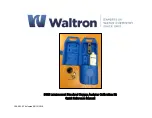
13
the chances the rods will be bent or broken. Likewise, it
is best to avoid areas with rocks or other material that can
cause the rods to deflect or bend. If the ground is espe-
cially hard or compact, you can use a Pilot Hole maker
(item 6430PH) to make 1½
”
holes to aid in starting the
insertion of the probe rods.
-
Press the
READ
button to initiate the measurement se-
quence. The reading should appear almost instantaneous-
ly.
Note:
The TDR rods are manufactured from type 303
stainless steel and are designed to bend if non
-
vertical
force is applied to them. This serves to protect the TDR
block electronics from potential damage that could be
caused by excessive force.
Occasional rod bending is normal, and can be expected
during the course of sampling. Longer rods will be more
susceptible to bending than shorter rods. If bending oc-
curs, rods should simply be bent back to parallel position,
perpendicular to the TDR block. Measurements will con-
tinue to be accurate provided that rods are reasonably
close to parallel.
If care is not taken to reposition rods to a parallel posi-
tion, subsequent pressure on the rods will accentuate the
bending and may cause the rods to break. Rods should be
considered maintenance items that may need to be re-
placed over time, depending upon the nature and frequen-
cy of sampling.














































